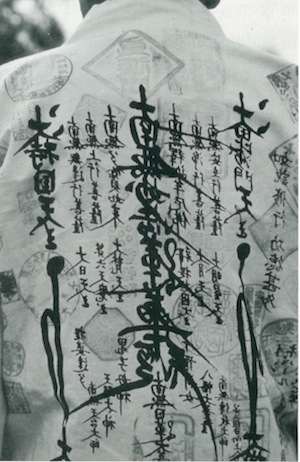The following are excerpts from Meeting the Buddha: On Pilgrimage in Buddhist India, a selection of writings by pilgrims from ancient times to the present, to be published in November by Tricycle Books (an imprint of Putnam/Riverhead). Here we have selected pieces from the sections on the pilgrimage itself and on Bodh Gaya.
In a discussion with his attendant Ananda, the Buddha delineates the basis for the eight holy sites in India. Tathagatarefers to the Buddha:
Ananda, there are four places the sight of which should arouse emotion in the faithful. Which are they? “Here the Tathagata was born” is the first [Lumbini]. “Here the Tathagata attained supreme enlightenment” is the second [Bodh Gaya]. “Here the Tathagata set in motion the Wheel of Dhamma” is the third [Sarnath]. “Here the Tathagata attained the Nibbana-element without remainder” is the fourth [Kusinagara]. And, Ananda, the faithful monks and nuns, male and female lay-followers will visit those places. And any who die while making the pilgrimage to theses shrines with a devout heart will, at the breaking-up of the body, be reborn in a heavenly world.
[From Thus Have I Heard: The Long Discourses of the Buddha, translated by Maurice Walsh, published by Wisdom Publications.]
It is said the Buddha spoke these words to his followers before dying for the last time. In death, the Buddha was thought to find release from samsara, the cycle of continuous re-births. His last words offered his followers a way to honor and remember their teacher and his teachings after his departure, and pilgrimage to the four sites of the Buddha’s life became an established form of Buddhist devotion. Within a few hundred years of the Buddha’s death, these four had multiplied, with places as far north as Gandhara claiming to bear traces of the Buddha’s passage through them. By the first century B.C.E., eight places had become canonical: the original four, Rajagriha, Sravasti, Sankasya and Vaisali.
Organized around significant places and monuments, the voices of travelers from the fourth to the twentieth centuries mingle in Meeting the Buddha with the voices of the Buddha, his biographers, and early disciples to bring readers on a voyage to the places where the historical Buddha has been honored by pilgrims for over twenty-five hundred years.
—Molly Emma Aitken, Editor,
Meeting the Buddha: On Pilgrimage in Buddhist India
The impulse to ramble is as old as humankind. We have ample testimony of a close ancestral connection to migratory animals, and it appears that the earliest calendars were incised animal bone, small enough to slip in a pocket as the human clan arranged its year by traveling seasonal food sources. Archaeologists are uncovering routes of migration our human forebears followed, keeping herds of reindeer and antelope, bison and sheep in sight. For most human beings, for tens of thousands of years, home was quite literally “on the hoof.” The hunter, the nomad, the rambler, and finally the pilgrim. Perhaps it is no more than the swift human intellect and our proud, strong legs following a primordial hunger to see what’s around the bend, over the next hill, or just upriver.
The early Buddhists were an order of “wandering alms-seekers.” A ragtag bunch, they could be found at crossroads and river fords, along highways, camping in city parks, or sheltering on forest groves. India would scarcely offer such a range of destinations for the Buddhist pilgrim had Shakyamuni Buddha settled into a secluded ashram like a Brahman priest, or lived out his days as a philosopher king in his father’s palace. The model he took for himself and his followers—that of philosophical rambler, beggar of food, tatter-robed paraclete, inveterate pilgrim—was an old one. Others before him had gone to the forests and highways for centuries, tired of rigid social forms and a predictable religion of the kitchen and bedroom. India’s great casteless community of the homeless was already ancient in Buddha’s day.

The pilgrim, the wanderer, the forest dweller, figures so familiar to the old epics, to poetry and legend, that the arts of India seem charged with them. The Buddha’s resolve as a young man to leave his father’s palace, what the annals call his Great Going-Forth, came after seeing the Four Signs. On successive days he encountered an old man, a sick man, a corpse and, lastly, a wandering mendicant on perpetual pilgrimage to the source of life. You meet similar mendicants on every pilgrimage route in India today, at all the temples and riverbanks. You see them on trains, in taxis and rickshaws, traveling by private cars. But mostly they have gone and continue to go forth by foot.
How can we separate the notion of pilgrimage from the primal instinct to set out on a walk, shake off the householder’s dust, and simply see something new? Our bones ache with it. The word pilgrim along with its Latin original, peregrine, simply means a person who wanders “across the land.” The old Sanskrit words from India spring from the same irresistible source. A yatrika is a rambler, a thirthayatrika a wanderer who frequents crossroads and riverbanks. You may think the world of nation states, superhighways, and rigidly drawn borders no longer accommodates such folk, but in India they ramble as they have for millennia—a tradition that traces itself back to a prehistoric pan-Asiatic shamanism.
—Andrew Schelling
from the introduction of Meeting the Buddha: On Pilgrimage in Buddhist India
Thank you for subscribing to Tricycle! As a nonprofit, we depend on readers like you to keep Buddhist teachings and practices widely available.